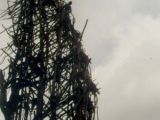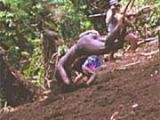The ritual of land diving (called N'gol) is no doubt one of the most spectacular events, with real risk to life and limb. Some think it stays behind the bungee jumping.
It is practiced by the indigenous of Pentecost Island in Vanuatu Archipelago (former New Hebrides), in the Pacific Ocean at 2000 km east off the Queensland's Australian coast. Currently, the jump is practiced only on the southern part of the island.
The local legend attributes the origin of the ritual to the legend of Tamale. The man had a younger women who run off often. He beat his woman and she ran away, hiding in a tall tree. Tamale climbed to her but as he made his final grab, she leaped. Tamale jumped after her, but while his wife had tied vines around her ankles and survived the fall, he crushed to the soil.
Men and boys, some as young as seven years, leap from the platforms in a show of strength and a statement to women that they can never be tricked again. The locals execute the ceremony to ensure a good crop of yams, their stable food. As the vines stretch, the land diver's heads curl under and their shoulders touch the ground, making it fertile for the following year's yam harvest. Every year, as soon as the first yam crop begins to show its green tips in early April, islanders begin building at least one huge wooden tower in each village, often as high as 25m. The ceremony lasts one or two days from April to early June.
Only circumcised men jump from these towers with only two long, elastic vines tied to their ankles to break the fall. The divers' hair is meant to touch the ground to fertilize it. Fundamentally, all the men of the village execute the ritual.
It occurs annually but it can be canceled by various reasons: too many men gone to work on plantations, rebuilding of a common house, late land works due to rainfalls, yam's composition. When the ceremony is to take place, the villagers look for a site to build the tower. The main factor is finding a slope with a moderate bias. One too steep would harden the work to construct; one too low would amplify the risks during the jump.
The tower has as a central pillar a tree trunk cleaned from branches. About 12 trunks 12-25 m tall are planted around the main trunk. No "material of the Whites" is employed. The trunks are bound only with branches and vines, very elastic after the rainy season. The tower is rectangular till 16 m, after that it curbs till the height of 25 m.
The tower is divided horizontally in 12 levels, every part corresponding to a part of the body from ankle to head. On these levels are bonded platforms of woven leaves and branches from where the men will jump. The last platform is situated on the highest level.
The construction is built in an atmosphere of friendship and exuberance, and locals sing and dance in a fragile balance, even mimicking the jump, but retreating in the last moment. When the armature of the tower is ready, it is said a neutral spirit enters into it.
Every man builds his own platform, using 2 trunks of about 3 m length and chooses the height from where he wants to jump and he can perform this several times if he wishes to do so.
The ground where the performers will land is previously prepared, all the rocks being removed. The soil is crumbled to a depth of 20 cm. The 7-8 years old boys are the first to jump from lower platforms at a height of 6 m. Men will jump from upper platforms. During the building of the tower, men follow some taboos: they are forbidden to have sex, and women must not approach the construction. A day before the jump, several men guard the towers all night long to impede any shaman to bury any object where the divers will land, otherwise accidents could happen.
In the morning before the diving, men oint their bodies with cocos oil and adorn with boar tusks and leaves (of Cycas, if they are of higher rank, or croton, if not).
The first to jump are 7-8-year old boys, from platforms located at heights of 6 m (20 ft). Sometimes, they must be pushed to take courage. Then men jump from higher platforms. Some jump 5 times.
As each man prepares himself mentally to jump, his friends tie vines to his ankles, and when he raises his hands the people below stop their singing, dancing and whistling. Before diving, he tells the crowd his most intimate thoughts, which may include family and marital problems. Because these could be his last words, the women below remain silent, despite any public revealing of family secrets.
Each performer crosses his arms over his chest and leans forward until he falls over the edge. When his body becomes horizontal, he jumps out as far as he can, avoiding impact.
If the diver were to fall straight down, he would hit the ground before being restrained by the vines, because they are measured some extra feet. The extra couple of feet added to the dive by jumping out enable the ropes to pull back the diver.
Sometimes, the vine brakes but the slope and the loosened soil will avoid severe accidents. Usually, everybody's all right at the end of the ritual, except for some scratched ankles. 10 days later the vines are cut and the tower is crumbled, the wood being used for fire.
Only one land diver is known to have died, during a visit of Queen Elizabeth II in 1974, when the Vanuatu was still a British colony. However, this happened during a dry season, when vines are drier and less elastic. Several of the vines ceded and one diver later died.
The Vanuatu government forbade the N'gol in 1995 as it had become too commercialized and wanted to keep the ritual's cultural value. Two sites at Pangi and Rangasusu, set aside for the entertainment of tourists, are the only ones where now the locals from all the island can execute their ritual.

 14 DAY TRIAL //
14 DAY TRIAL // 

